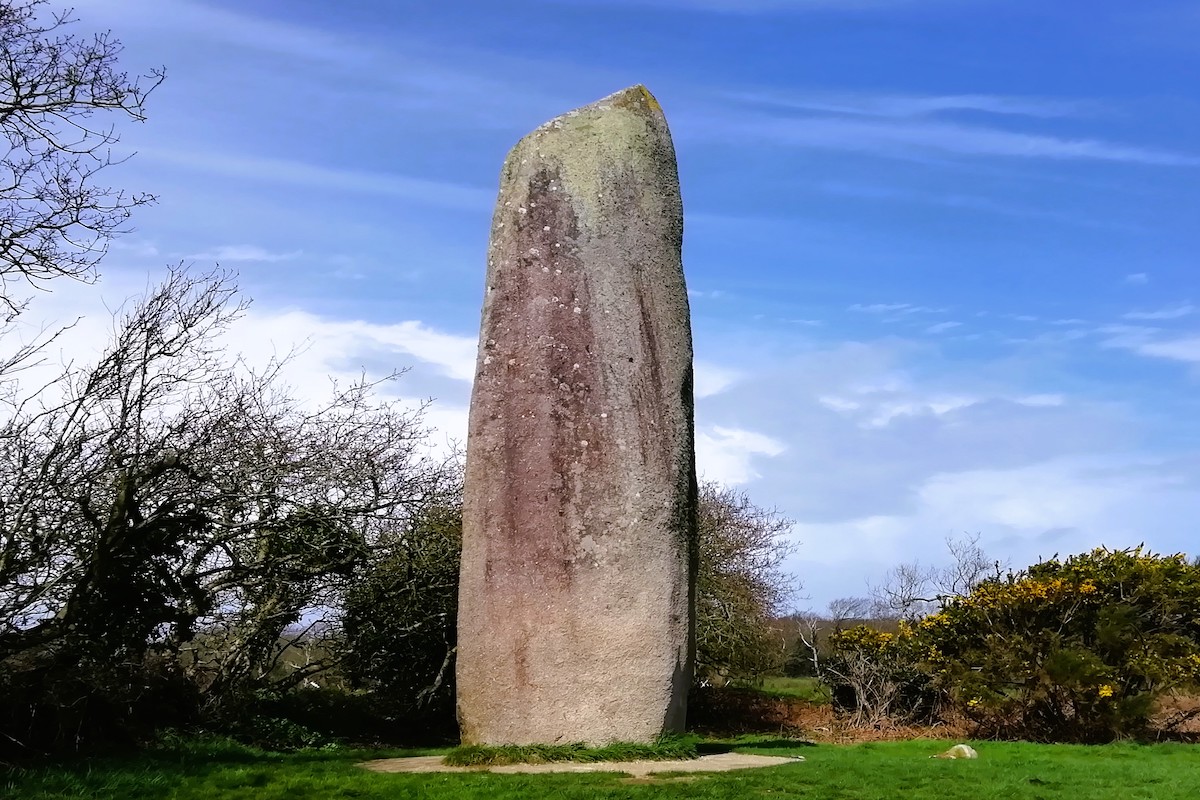The Menhir of Kerloas is situated on the western most point of Finistère, situated on the highest point of the Pays d’Iroise and is considered to be the tallest monolith standing anywhere in the world. It really is hard to miss and can be seen from 30km’s away and as many leagues out to sea.

First described as occupying a height of ‘forty French feet’ [1]. Alliteration aside, I find that description compellingly perplex, what is a French foot exactly? The traditional French units of measurement prior to metrification were established under Charlemagne during the Carolingian Renaissance. The pied du Roi or King’s foot was an undisputed measurement which would correlate to 326.6 mm (12.86 in). It measures 9.50 m high and 2.20 m wide.

It bore a Christian cross in 1839 and has also suffered a lightning strike which sliced a bit off, but either way a colossus. bThis very fine monument has an awe-inspiring presence. It is of granite, quarried some 2 km away, one can but wonder how it was transported up to the summit of its current location, let alone erected. The stone carved from a single piece of granite is finely bush-hammered on all sides and contains two curious bevels about waist height on either side and have earned it the nickname ‘The Hunchback’.
These protrusions are subject to much speculation and superstition. Jacques Cambry, a Breton writer, tells us in 1805:
” New brides lead their husbands there, make them kiss the stone, to be mistresses at home. A strange superstition causes men and women to rub their navels against this pillar to give birth to boys rather than girls, and the stone is worn and polished to the height of the belt “.

In 1832, Christophe-Paulin de la Poix, Chevalier de Fréminville, tells us:
“The newlyweds go devoutly to the foot of this menhir, and after having partly stripped themselves of their clothes, the woman on one side, the husband on the other, rub their bare bellies against one of these bumps. The man claims, by this ridiculous ceremony, to obtain male children rather than daughters, and the woman claims that by there she will have the advantage of being the absolute mistress of the dwelling and of governing her husband entirely.”
One ought to be careful in such places, one never knows what wrought of the ancient ones one is wont to bring down on oneself inadvertently. Some excavations have taken place here to reveal bronze age artifacts and a curious pavement of 20 meters long. Legends abound about it being the site of treasure visible only at midwinter.. Legend also tells us that at the stroke of midnight the menhirs ran to drink from the ocean and by the twelfth ring of the bell they have resumed their place, stoic, motionless, impervious to the attacks of time.
The area around the site is called Kerglass which translates as ‘field of grief’., and perhaps this points to it being an ancient burial site. What a lovely place of internment.

For all of what this stone reveals, there is a deeper unrevealed mystery. It had immense significance for the ancient people who went to great lengths and efforts to erect this imposing stone, trying to reach some higher purpose perhaps.
I felt so welcome at this site, so welcome in fact that I dawdled not wishing to leave. It is surrounded by verdant and fertile fields, a beautiful blossoming gorse blazoned in yellow and two young oaks stood as guardians. There is an inexplicable peace here. This megalith is reputed to have healing power and I can attest to that.
Longitude 48.426638 Latitude 4.679393.
Footnotes:
[1] Adolphus Trollope, Un été en Bretagne: journal de voyage d’un Anglais en Bretagne pendant l’été 1839, Ed. du Layeur, 2002 (ISBN 2-911468-59-7









